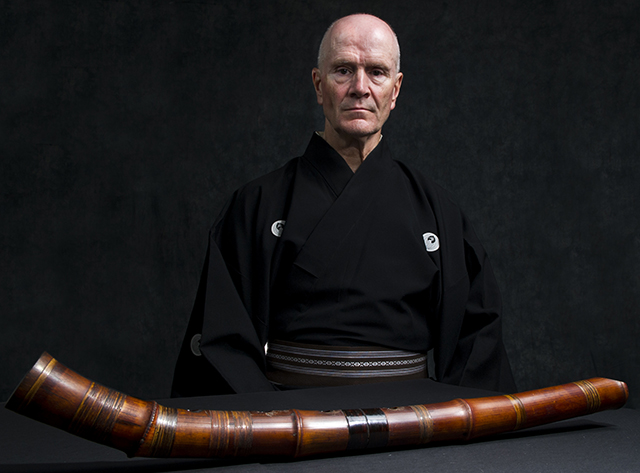Everything Zen

Stan Richardson joined the TAMBCD staff 35 years ago, but he started playing the Japanese bamboo flute long before that. Now he is Smithsonian bound.
The shakuhachi is a deceptively unassuming instrument. Traditionally fashioned from bamboo, this end-blown flute could blend in among surrounding stalks. The outer edges of the flute appear rough-hewn and simple. Playing it is a different matter. Some students of this school of music, which dates back to 17th century Japan and Zen Buddhism, play only a couple of months before growing disillusioned. Others last a few years. Only a select few become masters. Stan Richardson, senior lab coordinator in orthodontics, has studied the shakuhachi since 1972.
On Oct. 25, Richardson, one of only four master teachers in the U.S., will perform at the Freer Gallery of Art, one of the Smithsonian museums of Asian art in Washington. The event is part of a 40-year anniversary of the Mujuan Shakuhachi Dojo, his teacher’s school, founded by Yodo Kurahashi in Kyoto, Japan.

Whether Richardson is kneeling on a tatami reed mat for hour-long practice sessions with his music students or instructing orthodontic residents in the close quarters of his lab, seemingly unending reserves of patience have allowed him to excel at these otherwise mutually exclusive professions. It doesn’t appear that Richardson, who moved to the U.S. from England in 1979 to take the job at TAMBCD, will run out of this virtue anytime soon.
“The music requires such attention to detail; the study of it requires an incredible amount of patience,” Richardson says. “I work very closely with the orthodontic residents, and there are quite a lot of complicated techniques that I teach them, so it’s also pretty demanding, patience-wise.”
Dr. C. Moody Alexander, clinical professor in orthodontics, was department chair when Richardson was hired and is one of many colleagues privy to his musical stylings.
“I remember sitting on campus in Beasley Auditorium, and I hear this music, and here comes Stan with his Japanese kimono,” Alexander says. “It was an absolutely unbelievable moment.
“The thing about Stan is that he never does things halfway. He wants it to be the best. Whether it’s building a dental appliance, working with a first-year dental student or going to the Smithsonian, he’s a master craftsman.”

Pure coincidence led Richardson to the shakuhachi. His explorations in meditative Zen Buddhism yielded an album featuring the instrument played by a national living treasure in Japan.
“I thought, ‘music for meditation, that’s amazing.’ I bought it randomly and had no idea what it would sound like. I fell in love with the sound and thought, ‘I want to do that,’” says Richardson, also skilled at guitar, violin, viola, and Chinese and South American flutes.
The search for a shakuhachi commenced that weekend. But in the 1970s, acquiring a Japanese bamboo flute required a bit more effort than clicking through a Google search and placing an online order. A year passed before a company in Tokyo sent him a wooden version of the instrument.
 These days Richardson opts for the bamboo variety. A licensed master teacher — a credential that takes a decade to earn — Richardson has 10 students and is fluent in reading and writing Japanese music. His own study under teachers Ronnie Seldin and Japan’s Yoshio Kurahashi has resulted in performances in Sydney, and repeat trips to Japan to play during the World Shakuhachi Festival.
These days Richardson opts for the bamboo variety. A licensed master teacher — a credential that takes a decade to earn — Richardson has 10 students and is fluent in reading and writing Japanese music. His own study under teachers Ronnie Seldin and Japan’s Yoshio Kurahashi has resulted in performances in Sydney, and repeat trips to Japan to play during the World Shakuhachi Festival.
Locally, he has performed at the Dallas Museum of Art, with the Dallas Symphony Orchestra and alongside world-renowned cellist Yo-Yo Ma. During an Oct. 8 performance at Klyde Warren Park, a crowd of several hundred enjoyed the soothing sounds of the shakuhachi as traffic rushed past in the Woodall Rodgers Freeway tunnel below.
Richardson’s two albums, “Moon on the Water” and “Shakuhachi Mediation Music,” which sold more than 100,000 copies, have amped up the U.S. following for this beautiful but otherwise obscure form of music.
“I’m not mainstream in many things I do,” says Richardson. “I had dreams of becoming a great folk singer at one time. We are offered many paths in life; I just took a different route. Now I am doing just what I want to do.”